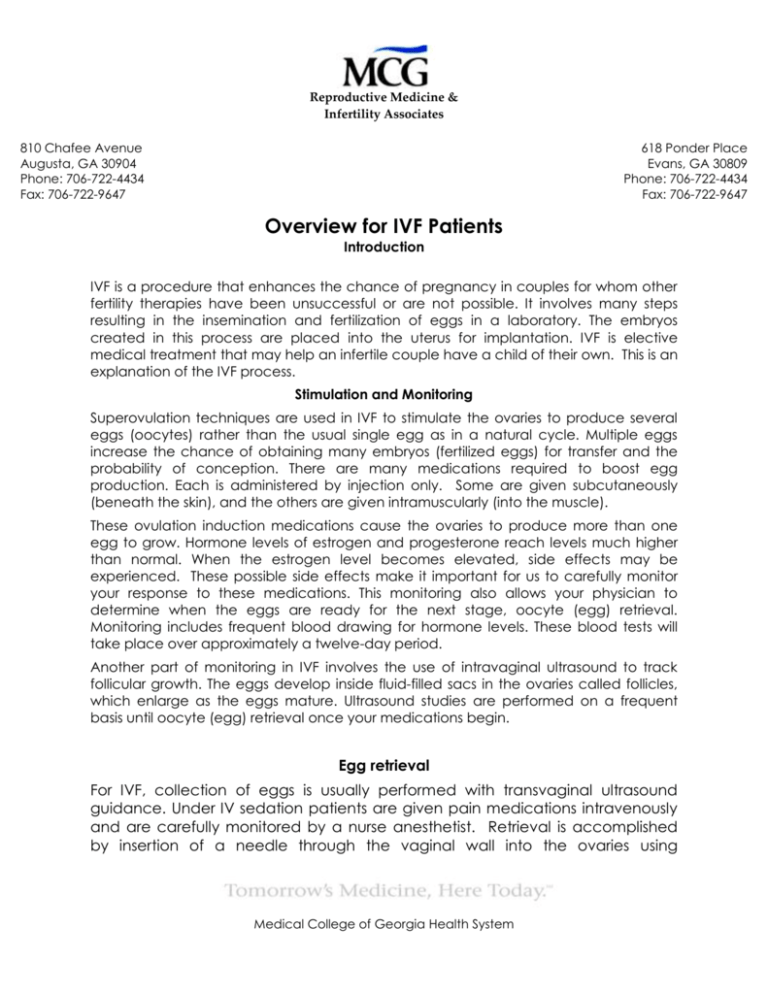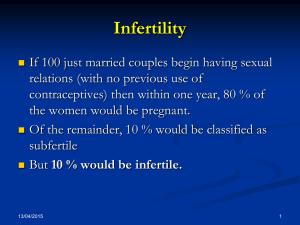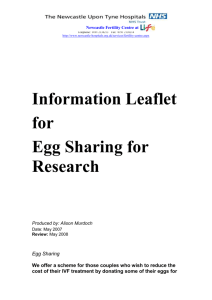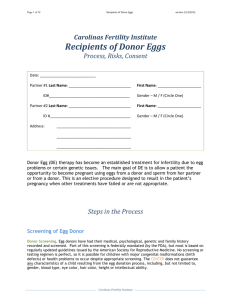Reproductive Medicine & Infertility Associates Overview for IVF
advertisement

Reproductive Medicine & Infertility Associates 810 Chafee Avenue Augusta, GA 30904 Phone: 706-722-4434 Fax: 706-722-9647 618 Ponder Place Evans, GA 30809 Phone: 706-722-4434 Fax: 706-722-9647 Overview for IVF Patients Introduction IVF is a procedure that enhances the chance of pregnancy in couples for whom other fertility therapies have been unsuccessful or are not possible. It involves many steps resulting in the insemination and fertilization of eggs in a laboratory. The embryos created in this process are placed into the uterus for implantation. IVF is elective medical treatment that may help an infertile couple have a child of their own. This is an explanation of the IVF process. Stimulation and Monitoring Superovulation techniques are used in IVF to stimulate the ovaries to produce several eggs (oocytes) rather than the usual single egg as in a natural cycle. Multiple eggs increase the chance of obtaining many embryos (fertilized eggs) for transfer and the probability of conception. There are many medications required to boost egg production. Each is administered by injection only. Some are given subcutaneously (beneath the skin), and the others are given intramuscularly (into the muscle). These ovulation induction medications cause the ovaries to produce more than one egg to grow. Hormone levels of estrogen and progesterone reach levels much higher than normal. When the estrogen level becomes elevated, side effects may be experienced. These possible side effects make it important for us to carefully monitor your response to these medications. This monitoring also allows your physician to determine when the eggs are ready for the next stage, oocyte (egg) retrieval. Monitoring includes frequent blood drawing for hormone levels. These blood tests will take place over approximately a twelve-day period. Another part of monitoring in IVF involves the use of intravaginal ultrasound to track follicular growth. The eggs develop inside fluid-filled sacs in the ovaries called follicles, which enlarge as the eggs mature. Ultrasound studies are performed on a frequent basis until oocyte (egg) retrieval once your medications begin. Egg retrieval For IVF, collection of eggs is usually performed with transvaginal ultrasound guidance. Under IV sedation patients are given pain medications intravenously and are carefully monitored by a nurse anesthetist. Retrieval is accomplished by insertion of a needle through the vaginal wall into the ovaries using Medical College of Georgia Health System Reproductive Medicine & Infertility Associates ultrasound to locate each follicle. The follicular fluid is drawn up into a test tube to obtain the eggs. Generally, the oocyte (egg) retrieval takes 30-45 minutes. Patients are usually discharged home within an hour after the retrieval. Collecting and Preparing the Sperm A semen sample will be obtained from the partner by masturbation on the day of the oocyte (egg) retrieval. This is usually obtained while the retrieval is being performed. Abstinence from ejaculation for two to three days prior to providing this semen specimen is recommended. After the specimen is produced, the sperm will be prepared for inseminating the collected eggs in our laboratory. A second sample of fresh semen is occasionally needed the day of retrieval to inseminate egg(s). Men who feel that they may have difficulty producing a semen specimen have the opportunity to have their specimens frozen by our laboratory ahead of time for use in this situation. Insemination of Eggs and Embryo Culture Following egg retrieval, the follicular fluid is immediately transferred to the nearby laboratory for identification of eggs, evaluation, and preparation for insemination. The prepared sperm will be added to each egg or injected directly into it if there is a sperm problem (ICSI) and they will be allowed to incubate overnight under controlled laboratory conditions. The next day, each egg is checked for evidence of fertilization. However, it is possible that no eggs are fertilized. If fertilization does not occur, the remainder of the procedure will be cancelled. The eggs that have fertilized will be allowed to develop for one or more additional days under controlled laboratory conditions before they are placed inside the woman's uterus (womb). Depending upon the couple's wishes, some fertilized eggs or embryos may be frozen and stored for future use. After the embryos are transferred to the uterus, the woman will take progesterone supplementation that begins on the day after the egg retrieval procedure. Progesterone is usually taken by injection. Administration of this medication after egg collection has been shown to create a more favorable uterine environment for the embryos, which increases pregnancy rates. Transferring Embryos to the Uterus Embryos are transferred to the uterus through a small tube (catheter). This procedure is much like a pap smear and does not require any anesthesia. The embryos are placed in a small amount of fluid inside the catheter, which is Medical College of Georgia Health System Reproductive Medicine & Infertility Associates passed through the cervix at the time of a speculum examination. The number of embryos transferred depends on individual circumstances of the couple and the day of transfer. This decision will be made collectively by you, your physicians and the embryologist. Many factors will be taken into account. The transfer of several embryos increases the probability of success. A multiple embryo transfer also increases the risk of a multiple pregnancy. The multiple pregnancy rate with IVF is about 28%. Most of these will be twins, but depending on the number of embryos transferred triplets or higher order multiples can occur. A procedure called “selective reduction” is available after counseling in these cases. We will give you written information and discuss this with you at your consult appointment. Embryo transfer can cause mild cramping. After transfer, the woman may get dressed and leave after a brief recovery period. A pregnancy test will be done twelve to fourteen days after the transfer, even if she has bleeding or spotting. Couples going through therapy must choose and formalize their choice for handling of any remaining embryos by indicating one of the following options: 1. Freezing (cryopreservation) of remaining embryos for use by the couple in future treatment cycles 2. Anonymously donating the embryos for use by another infertile couple(s), if the donating couple and the donated embryos meet the screening criteria (You would not receive any money for this donation, nor would they be sold.) 3. Allowing the embryos to develop in the laboratory until they perish, at which time they would be disposed of in a manner consistent with professional ethical standards and applicable legal requirements. Other Issues: Any assisted reproduction process or technique can be psychologically stressful. Significant anxiety and disappointment may occur. We encourage you to consider short-term supportive counseling during this time and we are happy to provide you with the name of counselors before you cycle to review your feelings and help you through what may be a difficult time emotionally for you and your partner. Medical College of Georgia Health System Reproductive Medicine & Infertility Associates A substantial time commitment is required by both partners to complete an entire course of IVF. It will be necessary for couples to adjust their schedules to undergo the required testing and therapies associated with IVF-ET. It is your responsibility to be available for scheduled ultrasound examinations and blood tests over the time period involved in the IVF process. It is the responsibility of the man to be available the day of retrieval and embryo transfer. Reasons for Unsuccessful Cycle: Unfortunately, neither conception nor a successful outcome of pregnancy is guaranteed by the IVF-ET procedure. There are many reasons why pregnancy may not occur with the IVF-ET procedure. In fact, there are complex and largely unknown factors that limit pregnancy rates following assisted reproductive techniques. Some of the known reasons for failure include: 1. There may be a failure to recover an egg because: - follicles that contain mature eggs may not develop - ovulation has occurred before time of egg recovery - one or more eggs cannot be recovered from the follicles seen - pre-existing pelvic scarring and/or technical difficulties prevent safe egg recovery 2. The eggs that are recovered may not be normal 3. There may not be enough semen to attempt fertilization of the recovered eggs because the man is unable to produce a semen specimen, because the specimen does not contain enough sperm for fertilization, or because the option to use a donor sperm as a "backup" was declined; 4. Fertilization of the eggs to form embryos may fail even when the egg(s) and sperm appear normal; 5. Embryos may not develop normally or may not develop at all. Embryos that do not appear to develop normally will not be transferred; 6. Embryo transfer into the uterus may be difficult/impossible, or implantation(s) may not occur, or the embryo(s) may not implant or develop normally after they are implanted in the uterus 7. Any step in the IVF-ET process may be complicated by unforeseen events, such as hazardous or catastrophic weather, equipment failure, laboratory conditions, infection, human error and other unforeseen events. Medical College of Georgia Health System Reproductive Medicine & Infertility Associates When pregnancy occurs following IVF, it will typically be a normal pregnancy. However, there is always a risk of abnormal pregnancy such as, miscarriage, blighted ovum, ectopic pregnancy or premature delivery. This is because the process of IVF-ET does not protect against such occurrences. Congenital abnormalities, genetic abnormalities, mental retardation or other birth defects which occur in approximately 3-4% of spontaneously conceived pregnancies may still occur in children born following assisted reproductive techniques. Women with multiple pregnancies have a much higher risk of complicated pregnancies, which may include the following: toxemia (pre-eclampsia), miscarriage, premature labor and delivery, stillbirth, birth defects, and other complications. Ovarian stimulation with the fertility medications causes multiple follicles to develop. Approximately 25-28% of pregnancies with IVF will be multiple. Most of these will be twins, but triplets, quadruplets or even greater multiple pregnancies can occur, but are rare. A procedure called "selective reduction of pregnancy" can be performed and may be considered after counseling. Alternatives to IVF-ET: Depending upon the individual and unique cause(s) of infertility for each couple, the chance of conception through alternative means, including intrauterine insemination (IUI) and medicinal therapy, other than IVF-ET may or may not exist. Possible success rates of these alternatives may vary depending upon the type and severity of the cause of the infertility. For some couples, it may even be possible to conceive spontaneously without a physician's help. You should discuss these alternative treatment methods with your physician before you proceed to treatment. Medical College of Georgia Health System Reproductive Medicine & Infertility Associates RMIA Clinic Medical College of Georgia Health System









